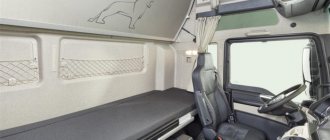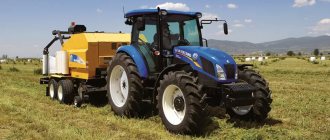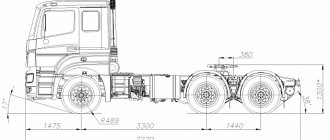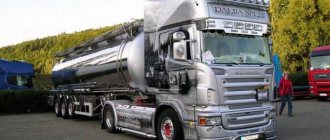Standard calculation of fuel consumption for vehicles (motor hours)
Attention! This forum is moderated. To gain access to it, you must register or log in to the site.
Pages: 1 Standard calculation of fuel consumption for a vehicle (motor hours) Visited Messages: 42 Authority: 10 Registration: 06/18/2012 11/20/2012 06:20:32
There is a vehicle with an hour meter that can operate at idle (l/h) and under load (l/h), the consumption rates are naturally different. In UAT PROF (1.0.7.1) in the fuel consumption standards there is only a standard per engine hour (l/h). Then we will set the norms for the load through the “Basic operating condition”, where we indicate the percentage by how much the fuel consumption rate for the load increases compared to the basic rate per engine hour. There is also a seasonal allowance (%) in the norms. So, when calculating a waybill in which a vehicle with an hour meter operates both under load and at idle, and at the same time a seasonal allowance is set for a given period, the calculation turns out, in our opinion, not entirely correct. Operation at idle and under load is reflected in the Task: for the 1st line the operating condition is empty, for the 2nd line the operating condition is the main operating condition of the vehicle. When calculating, it turns out that for a line with a working condition, the percentages of the working condition and the seasonal allowance are added up, and then multiplied by the base rate per engine hour, although in theory the load rate should first be calculated, and then the seasonal allowance should be applied to it. It's easier to explain with the following example:
The norm per engine hour (idling) is 5 l/h; The norm per engine hour (at load) is 8 l/h; (100%*8) / 5 = 160%, then the Basic operating condition is 60%; Seasonal bonus - 50%; The vehicle worked according to the waybill for 10 engine hours, of which 5 m/h - under load, 5 m/h - idling;
We calculate the consumption: 5 h * 5 l/h * 1.5 + 5 h * 8 l/h * 1.5 = 37.5 + 60 = 97.5 l
When calculating, the UAT gave a standard consumption of 90 liters, which is apparently obtained if you calculate it like this:
Dimensions and weight characteristics. Timber trucks Ural
| Fuel consumption of a JCB excavator Storing the finished substance for more than 10 days leads to the formation of a chemical bond between the additives, which reduces the service life of the engine. If it is necessary to convert fuel and lubricant consumption rates into volumetric units of measurement, liters, the following ratio should be used. |
| Norms for write-off of fuel and lubricants in 2022. Order of the Ministry of Transport of the Russian Federation You can calculate the volume of one edged board in a similar way: measure its length, width and height, multiply them, and you will get the cubic capacity of this board. Considering that the waybills contained indications of the locality where the transport was heading, the tax inspectorate, based on the available information, had the opportunity to determine the amount of tax by calculation. |
New consumption standards for fuels and lubricants • When processing wood, for example, which is frozen, the load increases significantly.
Calculation examples Operating features
| LET'S UNDERSTAND THE TECHNICAL CHARACTERISTICS OF THE KMU - PALFINGER INMAN IT-150 BASED ON KAMAZ-65117 Meanwhile, the factories conduct tests closer to extreme conditions, which are rarely encountered in real life, so the indicators may differ significantly. Understanding the speed and geographical location of the vehicle, we can confirm that this consumption is increased, but complies with the standards in these conditions. |
Let's summarize • This type of special vehicle has 2 or 4 hydraulic outrigger supports, depending on the modification.
Advantages and disadvantages – Ks-45717k-3r ovoid
| Truck crane KS-45721 Chelyabinets - technical characteristics Every season, specialists from the Galich Truck Crane Plant present to the market new and modernized models of GALICHANIN truck cranes, which are quickly gaining popularity and becoming leading in their class of lifting capacity. Among all wheeled cranes, the most valued are those that have the main qualities of versatility, multitasking, mobility and power. |
| Truck crane Galichanin 25t KS-55713 - description, characteristics, price Truck crane Galichanin KS-55713-1 on KamAZ 55111 chassis Truck crane KS-55713-1, Galichanin, KamAZ 55111, 6 x 4, Truck crane Galichanin KS-55713-1 with a lifting capacity of 25 tons mounted on the chassis of a KamAZ 55111, KamAZ 740 vehicle. Truck crane Galichanin KS-45719-1 on a chassis KamAZ-53215 Truck crane KS-45719-1, Galichanin, KamAZ-53215, 6 x 4, Truck crane Galichanin KS-45719-1 with a lifting capacity of 20 tons per chassis KamAZ-53215, KamAZ-740. |
Calculation examples
Let's consider a specific example: let's take a truck-manipulator (crane-board) HYUNDAI HD-120 with the following technical characteristics:
- Side loading capacity is 5 tons.
- Boom lifting capacity is 5 tons.
The prices for the supplier's services are as follows:
- The cost of a change is 9,000 rubles.
- The cost of an hour of processing is 1250 rubles.
- The cost of 1 km is 40 rubles.
We need to transport a change house from Moscow to Domodedovo. The distance between loading and unloading points is 45 km. The change house is standard, not insulated, weight 1100 kg, dimensions 6000x2400x2400, fits close to the end.
The power of a five-ton boom is sufficient for loading a storage unit from the end.
Tariff for shift 7+1 = 9000 rubles.
Calculation of delivery by manipulator: 45x2x40 = 3600 rubles (the distance between points is 45 km, we calculate the way there and back - 45 km x 2. The price of 1 km is 40 rubles).
What we get in the end: 9000 + 3600 = 12600 rubles.
If any difficulties arise along the way that are beyond the driver’s control (for example, the car was stuck in a traffic jam), then each hour of overtime costs 1,250 rubles (add to the calculated amount). If you need entry to pick up a cabin within the Third Transport Ring, then we add another 1000 rubles for entry into the Third Transport Ring.
16- and 25-ton © Ks-45717k-1r ovoid
| The GALICHANIN truck crane with a lifting capacity of 50 tons moves without special permits and dismantling of components | Truck crane Galician | Yandex Zen Other KS-55713-3K, KS-55713-5K, KS-55713-3K-3, KS-55713-3K-4, KS-55713-5K-2, KS-55713-5K-3 have a 6x6 wheel arrangement , KS-55713-5K-4 produced by the Klintsy plant; KS-55713-3, KS-55713-4, KS-55713-5, KS-55713-3V, KS-55713-4V, KS-55713-5V, KS-55713-6V from the Galichanin plant. The lifting gear is used to transfer the load from the rotating unit of the platform to the chassis frame and ensures circular rotation of the crane platform with the boom and working equipment. |
Technical characteristics of the manipulator. Principles of calculation
| Forklift fuel consumption - how to calculate real indicators - LLC; TechKomplektService; official website The work cycle of the CMU includes the following work operations - raising and lowering the boom; — extension and retraction of sections of telescoping sections; — lifting and lowering the load using a winch; - rotation of the column. Photo-1 shows the place where the intake suction hose is compressed, in which the live cross-section is significantly reduced, which is the main reason for the cavitation mode of operation of the pump. |
- Depending on the total weight of the materials, the vehicle's carrying capacity is determined.
- The weight of each location is important when choosing the boom capacity.
- The boom reach is affected by the distance of the cargo from the loading site (from the vehicle).
- The type of chassis is chosen taking into account the terrain and the condition of the roads along the truck’s route (a regular road vehicle or an all-wheel drive all-terrain vehicle).
Principles of calculation • The main thing is to rationally use the supplier's advantageous offers.
Fuel consumption standards for a front loader in practice
Using the SEM 650B front loader as an example, we will look at how the official fuel consumption data differs from the real picture. First, let's calculate the fuel rate using the above formula. The loader engine has a power of 220 hp. – a loader with a lifting capacity of 5 tons. The engine power of this loader is 162 kW, the time for which we will calculate fuel consumption is 1 hour, the specific fuel consumption for this machine is 220 g/kWh, any load percentage can be taken, and the fuel density, as mentioned above, is constant – 850g/l.
As a result, it turns out that for 100% load the fuel consumption will be 42 l/h, for 75% load - 31.5 l/h, and for 60 and 50% - 25.2 l/h and 21 l/h, respectively.
This forklift fuel consumption can be submitted to the organization's accounting department, and the figure obtained through such calculations will be considered an official indicator and will supplement the fuel consumption accounting data. However, in practice the situation is different.
In reality, you will need significantly less fuel. Of course, sometimes the technological process requires the engine to operate at the highest speeds, however, as a rule, this practically never occurs in real work. The specific fuel consumption figure, designated G in the formula, is almost impossible to verify. Equipment sellers often do not know what tests are carried out at factories to obtain this indicator - they simply obtain the value and report it to the buyer. Meanwhile, factories conduct tests closer to extreme conditions that are rarely encountered in real life, so the performance may differ significantly.
Thus, if you hear from a seller a questionable value for specific fuel consumption, be sure to ask what the value is in practice. Very often, large companies that sell special equipment specifically collect data from customers who are already working with their equipment in order to navigate real fuel consumption indicators. If you contact such a company, they will explain to you what fuel consumption is required for a specific front loader model in accordance with the expected operating conditions and load.
Crane manipulator control devices
For simultaneous telescoping of the boom, intermediate sections of the boom are marked with marks, showing the capabilities of the crane installation with each section extended to its full length. This formula is the following N t U p, where N is the engine power of the loader in kW, t is the time for which the fuel consumption for the loader is calculated 60 minutes, G the specific fuel consumption of the front loader in g kW per hour, U the load of the loader during operation , and p is the density of the fuel used.
Table 6. Correction factor for soil moisture Overloaded timber trucks
| Fuel consumption standards for special equipment. Appendix No. 4. Thus, at present, on the basis of paragraph 6 of the Decree, organizations have the right to include in the standardized costs when calculating income tax the cost of fuel for the special equipment specified in the question, spent within the limits established by the head of the organization. A modern KamAZ vehicle with a CMU crane-manipulator is a reliable mobile crane unit designed to perform tasks in the Far North; |
Features of operation - Calculation examples
| Standard calculation of fuel consumption for a vehicle (motor hours) If you handle outriggers carelessly, there is a risk that your fingers may be pinched, so hold the lever with one hand and push the outrigger with the other hand. KamAZ with a manipulator is a multifunctional technique that can be used to perform loading and unloading operations with various cargoes, as well as installation of drilling and production equipment. |
Operation of the manipulator crane. • The maximum reach of the five-section boom is 19 m, thereby allowing work to be carried out at a remote distance from the vehicle.
Table 1. Density of automobile and diesel fuel and lubricating oils at +20°C
When moving without cargo, the trailer is lifted onto the tractor itself, which increases cross-country ability and also allows you to move more freely on public roads. 2008 F08-188 08-185A in case A53-6449 2007-C5-37-22 it is noted that shortcomings in the preparation of waybills, in particular the absence of a speedometer reading, cannot serve as a basis for concluding that the company does not comply with the requirements of tax legislation.
Safety rules when working with a crane manipulator.
Thus, if you hear from a seller a questionable value for specific fuel consumption, be sure to ask what the value is in practice. Very often, large companies that sell special equipment specifically collect data from customers who are already working with their equipment in order to navigate real fuel consumption indicators. If you contact such a company, they will explain to you what fuel consumption is required for a specific front loader model in accordance with the expected operating conditions and load.
Reviews and how much does the manipulator cost?
If the first layer of cable is wound unevenly, the cable wound on top of this layer may get caught between the turns of the first layer, which will lead to uneven winding and jerking of the cable during operation. This formula is the following N t U p, where N is the engine power of the loader in kW, t is the time for which the fuel consumption for the loader is calculated 60 minutes, G the specific fuel consumption of the front loader in g kW per hour, U the load of the loader during operation , and p is the density of the fuel used.
But it is worth paying attention to the idling time, whether there was a need to warm up the vehicle if the driving time was only 4 hours. After calculating, to the amount received, you must add possible costs for additional services that are not included in the standard list, depending on your personal needs.
| Tractor fuel consumption. Calculation rules, norms A conscientious service provider will try to calculate the cost taking into account all the features of the work to be done, take into account possible additional costs and provide discounts if this is provided in your case. The specific fuel consumption curve may vary significantly depending on the type of forklift engine, and it is the responsibility of the dealer to know this value for your model. |
- Paved roads; field roads; packed snow roads.
- Roads with gravel, crushed stone (broken) or sandy (country) surfaces; unpaved roads after rain; turfed soil with hard surface; stubble of grain crops.
- Deep rutted roads; frozen or normal moisture arable land; ridge roads; thawed after a thaw; field after collecting root crops; virgin snow; off-road spring; broken roads.











